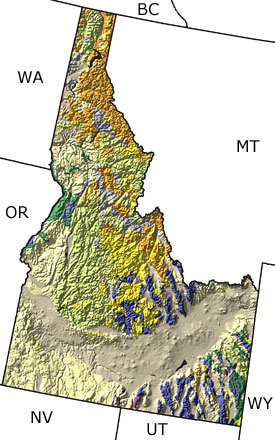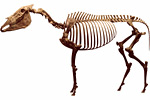

Idaho, US |
|||||||||||||||||||||||||||||||||||||||||||||||||||||||||||||||
|
|||||||||||||||||||||||||||||||||||||||||||||||||||||||||||||||
Paleontology and geologyThe Precambrian: The Precambrian is represented in Idaho predominantly by metamorphic rocks. Some of these were originally sediments, which have been slightly to moderately altered. The only known Precambrian fossils in the state are stromatolites and some possible trace fossils found in southeastern Idaho. The Paleozoic: The Paleozoic was a time of fluctuating sea levels. A shallow sea covered parts of Idaho during most of the Early Paleozoic, and a diverse assemblage of invertebrate animals inhabited the marine environments. The oceans receded during the Silurian and most of the Devonian, but then returned and most of the state remained under water during the Carboniferous and Permian. Some poorly preserved plant fossils and a few thin coal layers indicate that marine deposition was interrupted by periods of uplift and erosion; however, few of these terrestrial deposits have been found. The Mesozoic: Triassic and Jurassic outcrops consist of metamorphosed and sedimentary rocks. These deposits have yielded a variety of marine fossils including molluscs, echinoids, corals, bryozoans, brachiopods, shark teeth, and fragmentary remains of an early ichthyosaur. The presence of raindrop impressions in the Jurassic rocks in southeastern Idaho suggests that some of the sediments were terrestrial or at least exposed during low tides. Cretaceous rocks in most of the central part of the state are igneous and do not contain any fossils. However, some terrestrial and freshwater sediments occur in the eastern part of the state and contain fossils of dinosaurs and other vertebrates, as well as fresh water molluscs, ostracods, and plants. The Cenozoic: Tertiary rocks in Idaho are mostly volcanic or river and lake deposits that contain fossils of fish, mammals, and plants. The plant fossils suggest that the climate was milder than it is today. Quaternary rocks consist primarily of lava flows, glacial deposits, and fossiliferous lake and river sediments. Hundreds of vertebrate species are known from these deposits, including mammoths, horses, camels, bison, mountain sheep, ground sloths, rodents, rabbits, birds, snakes, lizards, and fish. |
|||||||||||||||||||||||||||||||||||||||||||||||||||||||||||||||
Links to more on Idaho paleontology |
|||||||||||||||||||||||||||||||||||||||||||||||||||||||||||||||
|
Organizations | Education and Exhibits OrganizationsEducation and Exhibits
|
|||||||||||||||||||||||||||||||||||||||||||||||||||||||||||||||
|
site tour |
about the site |
site map |
site credits |
page credits |
help |
FAQs |
contact |
||

